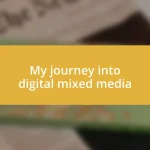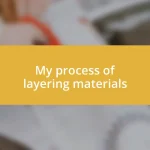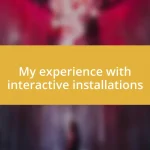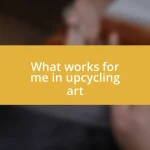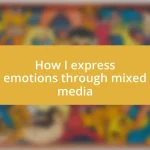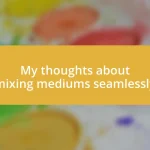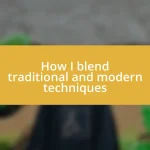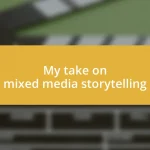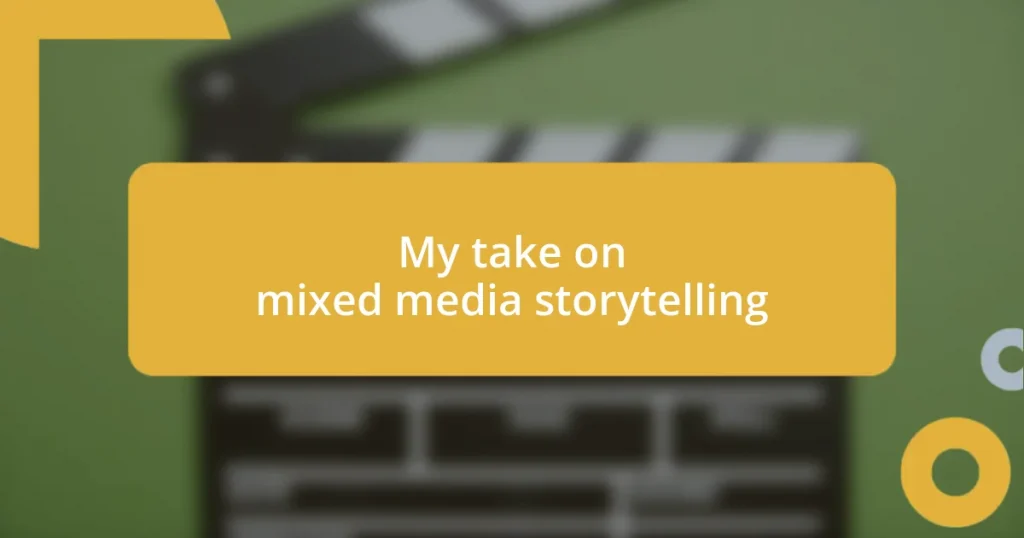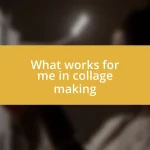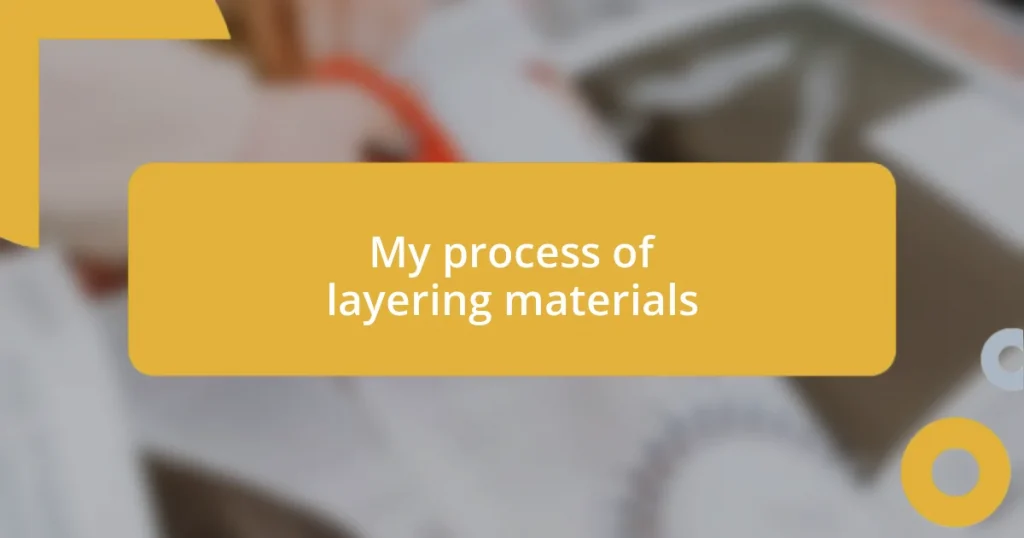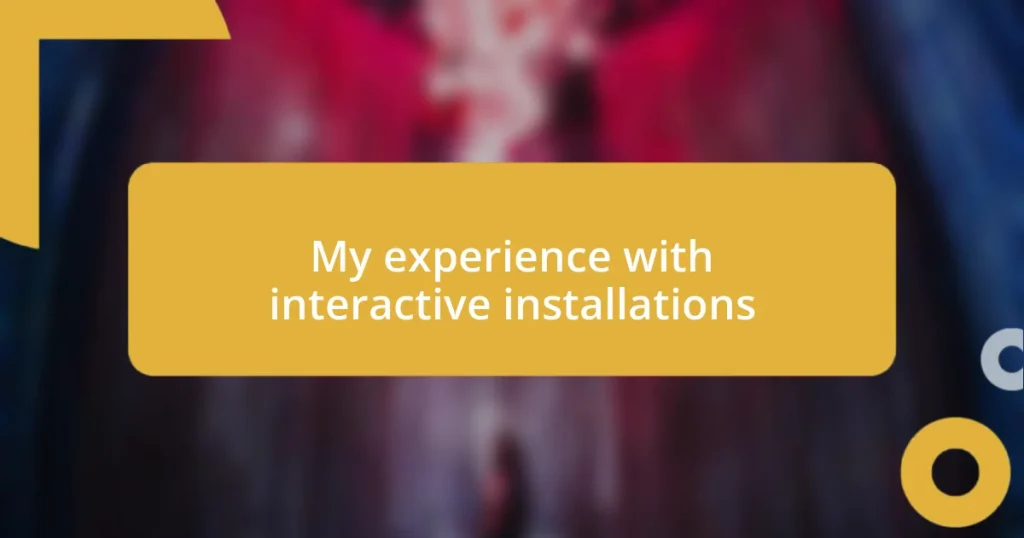Key takeaways:
- Mixed media storytelling enhances narrative engagement by integrating various artistic elements like text, visuals, and audio, creating a more immersive experience.
- Employing diverse storytelling techniques, such as suspense and visuals, evokes empathy and deepens audience connections, enhancing the emotional impact of narratives.
- Utilizing the right tools, both digital and physical, allows creators to enrich their stories and evoke emotions, making the storytelling process a multi-sensory journey.

Understanding mixed media storytelling
Mixed media storytelling is a fascinating way to blend various artistic elements to create a more immersive narrative experience. I remember the first time I encountered a mixed media piece at an art exhibit—it was a combination of video, collage, and live performance. It struck me how each medium contributed a unique flavor to the story, urging me to think deeply about the connections between them.
By integrating text, visuals, audio, and sometimes even interactive components, creators can engage audiences on multiple levels. Have you ever found yourself lost in a story that unfolded through a series of photographs and narrations? I have, and it made me realize how different mediums can evoke different emotions, pulling me deeper into the narrative’s heart and soul.
What excites me most about mixed media storytelling is its versatility. It allows creators to break free from conventional methods and experiment with how stories are told. I often wonder, how can one medium truly capture the essence of a moment? This exploration inspires me to think outside the box and embrace the layers of storytelling that can emerge when various art forms come together.

Importance of storytelling techniques
Storytelling techniques are essential because they shape how we connect with narratives. When I reflect on my favorite stories, it’s often those with carefully crafted techniques that resonate the most. For example, employing suspense can keep an audience on the edge of their seats, much like the thrill I felt during a live performance where the story lingered in the air, waiting for the climax to unfold.
Diverse techniques enhance the richness of a story, allowing different dimensions to emerge. I recall a project I worked on where I combined poetry with visual art. Each piece of art echoed the emotion behind the words, creating a synergy that deepened our viewers’ understanding. This fusion not only grabbed attention but also invited them to experience the artwork and poetry as a unified expression of thought.
Incorporating various techniques offers an opportunity to evoke empathy and provoke thought. One time, I read a graphic novel that brilliantly wove in different styles, allowing me to decipher the protagonist’s turmoil visually and emotionally. This experience reinforced my belief that the right storytelling techniques can stir our feelings and spark insightful conversations long after the story concludes.
| Storytelling Technique | Importance |
|---|---|
| Suspense | Keeps the audience engaged and eager for resolution. |
| Visuals | Add layers of meaning and emotional depth. |
| Interactions | Allow audiences to become active participants, deepening their connection. |

Exploring different media types
Exploring different media types is where the magic of mixed media storytelling truly comes alive. I’ve had the chance to experiment with various media types, and each one feels like a new brushstroke on the canvas of my narrative. For instance, while collaborating on a digital story, I discovered how the blend of documentary-style video with handwritten notes added a personal touch that made our audience feel like they were part of our journey. This combination not only informed but also evoked a sense of intimacy, inviting viewers deeper into the narrative’s emotional landscape.
When it comes to exploring media types, each one can serve a unique purpose. Here’s a quick overview of some media types and their impact:
- Photography: Captures moments that words sometimes fail to express, offering visual storytelling that sparks imagination.
- Audio: Provides a rich soundscape that can evoke emotions, whether through music, narration, or ambient sounds.
- Illustration: Adds a whimsical or serious tone that enhances the narrative, allowing for artistic interpretation of the story.
- Video: Combines movement, sound, and visuals to create a dynamic storytelling experience, engaging viewers in a multi-sensory way.
- Text: Grounds the narrative, providing context and deep reflections that help shape the audience’s understanding.
By integrating these different media types, I often find that the story evolves in unexpected ways. Each medium contributes its own flavor, allowing stories to bloom in directions I hadn’t initially imagined. It’s this journey of discovery that keeps me energized and passionate about the art of storytelling.

Integrating visuals and text
Integrating visuals with text can transform a story from ordinary to extraordinary. I remember a time when I paired evocative imagery with a personal blog post. Each photo I chose mirrored the emotions I expressed in my writing, guiding my readers through my thoughts. It’s like painting a picture with words; when the two elements harmonize, they create a richer narrative that grabs attention.
I’ve also found that juxtaposing visuals and text can spark curiosity. During one of my projects, I included infographics alongside short anecdotes. This approach allowed readers to digest complex information easily while inviting them to explore the stories behind the data. Had I ever considered how visuals could enhance comprehension? Absolutely! I’ve seen firsthand how this integration can make intricate topics much more accessible and engaging.
When visuals and text work together, they usher the audience into a multi-dimensional experience. For instance, I once collaborated on a zine where vibrant illustrations accompanied snippets of poetry. The interplay of colors and words captured the essence of each piece, leaving a lasting impact. Isn’t it fascinating how a striking image can linger in our minds just as profoundly as a well-crafted sentence? This fusion encourages readers to not just see or hear the story but to truly feel it.

Best practices for cohesive narratives
Crafting cohesive narratives in mixed media storytelling begins with a clear vision. I recall a project where I had a compelling concept but struggled to connect the various media cohesively. After simplifying my main message, I found that each medium I used amplified that central idea, creating a seamless flow. It’s amazing how clarity can transform chaos into a beautifully woven tapestry.
One practice I’ve learned is to focus on thematic consistency. During my exploration of a series on environmental issues, I noticed that visuals depicting nature’s beauty alongside stark images of environmental degradation created a powerful contrast, driving home the urgency of the message. This emotional tug—a mix of awe and sadness—bound my narrative together. Isn’t it remarkable how a consistent theme can anchor an audience’s emotional journey?
Moreover, embracing feedback is pivotal in achieving cohesion. On one occasion, I presented early drafts of a multimedia piece to a trusted group of friends. Their insights helped me identify which elements felt disjointed and which resonated. Listening to different perspectives brought a fresh lens to my work, guiding me to refine and align the elements more closely. How often do we overlook the power of collaboration in shaping our narratives?

Tools for creating mixed media
The right tools can make a world of difference in mixed media storytelling. I remember the first time I delved into digital editing software, such as Adobe Creative Suite. The ability to layer images, add text overlays, and manipulate colors allowed me to create visuals that vividly enhanced my stories. I still find it incredible how technology can breathe life into a narrative; in a way, it feels like a brush in the hands of an artist, ready to create something new.
When it comes to physical materials, I’ve often turned to simple items like collage materials—old magazines, fabrics, and even found objects. My favorite project involved layering textures and colors with cutouts to form a visual narrative that complemented my written piece. It’s astonishing how tangible items can evoke emotions and draw readers into the story. Have you experienced the tactile magic of mixing different mediums? It’s a sensory journey that no digital tool can replicate.
Exploring audio and video as part of mixed media narration has been a game changer for me. I once recorded ambient sounds from a local park, pairing them with a reflective essay I wrote about my experiences there. The gentle rustle of leaves combined with my words created an immersive atmosphere. It made me realize how sound can amplify emotion, transforming a straightforward piece into a sensory experience that lingers in the mind. Isn’t it powerful how combining different formats can captivate the audience on multiple levels?
